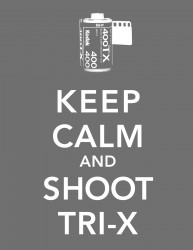And now, the news…
First up, a sad day, the end of an era;Â Hasselblad has just discontinued the last of their classic all-manual line of 6×6 cameras, the 503CW. I have to admit I was entirely unaware of their still being sold new, which speaks poorly of whatever effort Hasselblad might have been making to market the line.
Besides, they were effectively having to compete with their own excellent product, available in great numbers and at (relatively) reasonable prices in the used market. The ‘Blad is still in high demand among discerning film shooters with a bit of money to spend but it was a huge seller in its day, built to last, and now all those bulletproof, everlasting cameras are on the used market while their former owners mortgage off assorted internal organs and excess offspring to keep up with whatever new digital gear they need to buy this month.
It will be interesting to see what this does to used prices (my guess: approximately bugger all, unless a bunch of people who are still using the system professionally all get spooked at the same time and dump their gear into the used market). As I write this, one can assemble a quite complete used system for maybe $2,000 if really long, really wide and macro lenses aren’t your thing and you don’t mind buying what KEH rates as “BGN” condition (you have nothing to fear here, in my experience). A little less if you can deal with a 500C instead of a C/M.
 On a different note, there’s Kodak, who have just sold their film division to their own UK pension plan.
On a different note, there’s Kodak, who have just sold their film division to their own UK pension plan.
Eastman Kodak Company today announced a comprehensive settlement agreement with the U.K. Kodak Pension Plan (KPP), its largest creditor, with respect to its Chapter 11 Plan of Reorganization.
So, if I understand this correctly, Kodak owed it’s UK pension plan a ton of money. Probably best not to ask how that state of affairs came to be.
Under the agreement, which will be filed with the U.S. Bankruptcy Court, Kodak’s Personalized Imaging and Document Imaging businesses will be spun off under new ownership to KPP.
That doesn’t much clarify what exactly the folks at KPP now own. Luckily Kodak’s press release tells us later on (emphasis added):
The Personalized Imaging business consists of Retail Systems Solutions, the world leader in retail photo kiosks and dry lab systems, offering retailers a competitive advantage in the photo services market; Paper & Output Systems, offering photo specialty retailers, professional and wholesale labs, and photographers the broadest portfolio of traditional photographic paper and workflow solutions; Film Capture, offering consumers and professionals an award-winning range of still-camera film products; and Event Imaging Solutions, offering theme parks and other venues a total solution in souvenir photo operations.
So Kodak PI includes their still film lineup and photo paper, which are the parts of interest to people like me (the photo chemicals division was sold off several years ago and still makes the familiar products in the yellow packaging).
What does this mean for the future of Kodak film? Well, they could try to operate PI and DI as profitable businesses, spin them off as going concerns, or asset strip them for some quick cash. What does the PR say (my emphasis added again)?
The businesses that we are acquiring will deliver long-term cash flows to support the plan’s obligations. The financial stability that KPP will provide for the Personalized Imaging and Document Imaging businesses will be beneficial to those businesses’ employees, customers and partners.
So they want long-term cash flows from these bad boys. That implies running PI and DI as profitable businesses in the long term; you don’t get a “long term cash flow” from a company by selling it off or parting it out. Also backing this up there is a (subscriber only) report on the Wall Street Journal which is quoted at PDN Pulse:
KPP plans to hire new executives to run the Personalized Imaging and Document Imaging businesses so they can generate cash flow for the pension plan, rather than finding a buyer for the businesses.
Sounds like they’re in it for the long haul, indeed. This is entirely feasible, as proven by Harman Technology/Ilford Photo’s continued success, and it seems fair to assume that Kodak PI is in rather better shape than Ilford was immediately prior to their turn-around and resurgence.
My read on the “financial stability” part is that Personal Imaging and Document Imaging are now free of the uncertainty of the parent company’s fate, where financial stability presumably meant “we are in a downward trajectory which will remain stable until such time as we arrive at the ground”.
I believe this bodes well for Kodak’s film lineup. Time, of course, will tell.